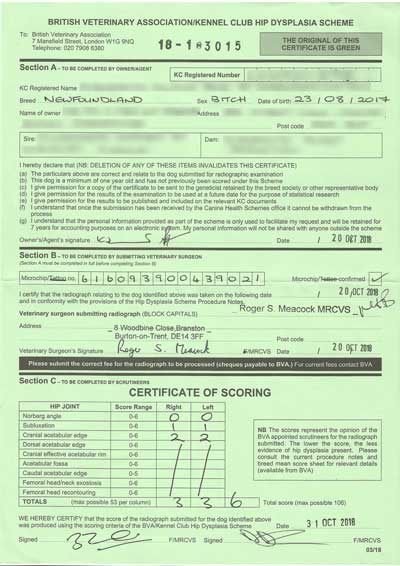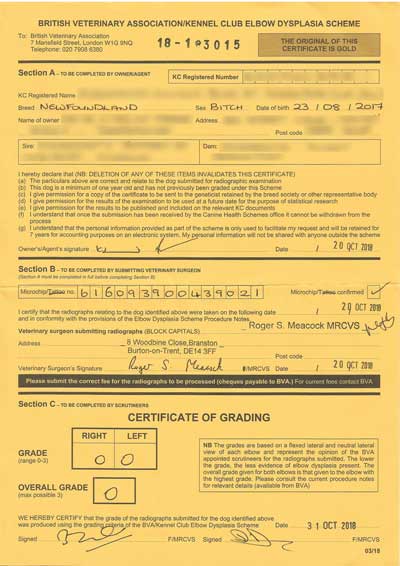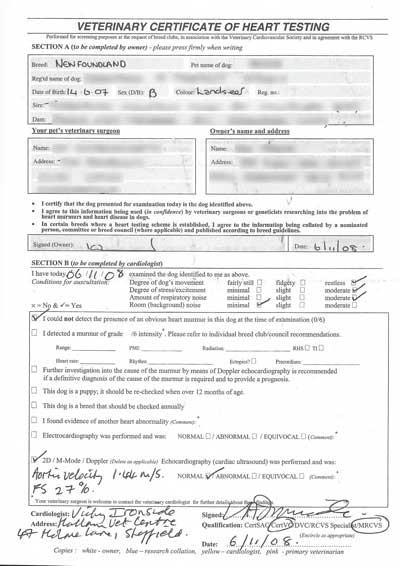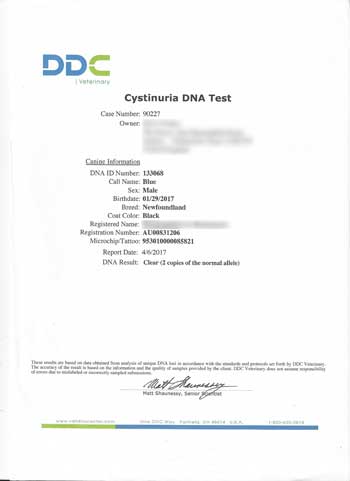HEALTH MATTERS
Many of the potential health issues which can affect Newfoundlands are hereditary linked. A number of tests should be carried out on potential breeding dogs and bitches, including;
HIP SCORING
Hip scoring is done by way of x-ray when a dog is a minimum age of one year old. The microchip number is scanned to ensure the correct dog is being x-rayed and the dogs kennel club name and its sire and dam are added to the official form along with the owner details and their veterinary details. The x-ray is then sent to The Kennel Club who work with the BVA (British Veterinary Association) to be scrutinized by a panel of experts and a score is given. Each component of the hip is given a score, which is added together to give that hip its score. At best the score is 0 (zero) no dysplasia evident, at worst the score is 53 therefore severe dysplasia is evident. The other hip is scrutinized in the same manor and given its score, at best 0 (zero) and worst 53. These two scores, one for the left hip and one for the right are added together to get the dogs final score. At best 0/0 a total of 0 (zero), and worst 53/53 total of 106. Both hips may have the same even score i.e. 8/8 total 16 or they could well be different and uneven 3/13 total 16. The lower the score the better when it comes to breeding stock.
The results are sent by way of a Certificate to the owner and published on The Kennel Club website which can be viewed here. The Kennel Club also provides a breed median score, which fluctuates from time to time. At present the average is 11.
There are other comparable schemes run by other countries that are also acceptable but the scoring my not be given in exactly the same way.
ELBOW SCORING
Elbow scoring is done by way of x-ray when the dog is a minimum age of one year old. The microchip number is scanned to ensure the correct dog is being x-rayed and the dogs Kennel Club name along with its sire and dam are added to the official form along with the owner details and their veterinary details. The x-rays are then sent to The Kennel Club who work with the BVA (British Veterinary Association) where they are scrutinized by a panel of experts and a score is given. Each component of the elbow is given a score, which is added together to give that elbow its score. At best 0 (zero), and at worst 3. The other elbow is scrutinized in the same way and given its score, at best 0 (zero) and worst 3. Unlike the hips these scores are not added together for a final total score. The elbow displaying the highest score is the final score. So a 1/3 is scored as 3, likewise a 3/3 is also scored as 3. The lower the score the better i.e. 0/0 total 0 (zero). These results are sent by way of a Certificate to the owner and published on The Kennel Club website which can be viewed here.
There are other comparable schemes run by other counties that are also acceptable but he scoring may not be given in exactly the same way.
HEART TESTING
Heart testing is done by way of an Echo Doppler scan which needs to carried out by a specialist veterinary cardiologist with a qualifying Diploma (a list of these can be found here) when the dog is a minimum age of one year old.
The microchip number is scanned to ensure the correct dog is being scanned and the dogs Kennel Club name along with its sire and dam are added to the official form along with the owner details and the details of their regular veterinary practice. After a stethoscopic examination to check for any audible issues a small area of the dogs chest is shaved and an ultrasound scan of the heart is carried which measures and charts the flow of blood through the heart chambers.
The cardiologist is looking for evidence of any murmur, DCM (Dilated Cardio Myopathy) or SAS (Sub-aortic Stenosis). If any of these are found they are recorded on the certificate. The blood flow is recorded through the mitral valve and given an average flow rate. At present the blood flow rate target is 1.7 mils per second or less. A conclusive result is given on the certificate and marked as either Normal, Equivocal or Abnormal.
The results of this test are immediate and a Certificate of Heart Testing is issued to the owner, with a copy being sent to their veterinary practice and a further copy being sent to the Breed Clubs scheme for its records.
For breeding purposes a Normal result is best but dogs with an Equivocal result can be used in a breeding programme with carful selection of a mate. Dogs with an Abnormal result should NEVER be used in any circumstances for breeding.
The Newfoundland Club in association with the Southern Newfoundland Club and the Northern Newfoundland Club maintain a database of Heart Test results which can be freely access here.
CYSTINURIA
Cystinuria testing is carried out by way of a DNA swab taken from the inside of the dog's cheek. This can be done at any age and at present doesn't have to be done by a veterinary surgeon. The swab is sent to a testing laboratory to be analyzed and the results sent back by way of a report/certificate indicating whether the dog is either clear/free, a carrier or an affected animal.
Examples of Cystinuria Test results (click to enlarge)
For breeding purposes a clear/free dog is best but a carrier may also be used for breeding but only with clear/free dog. Dogs with an affected result should NEVER be used in any circumstances for breeding.
The results of this test can be sent to the Kennel Club who record and publish the results. Their database can be viewed here.
FREQUENTLY ASKED QUESTIONS
Why do we carry out these health tests – do they really matter?
The Breeders For Life listed within this site endeavor to breed from the healthiest stock and can only know a dogs health status by testing for hereditary diseases. In this way they make informed choices as to which dogs they use in their breeding programmes.
What are Estimated Breeding Values (EBVs)?
The Kennel Club has established a tool for breeders to help them make informed choices when breeding. These choices are based on the genetic risk of inherited disease.
The EBV calculations use the KC/BVA hip and elbow scoring scheme data and pedigree information of the individual dog to more effectively determine the genetic risk which a dog may pass on to its progeny.
The KC's EBV for specific Newfoundlands can be found here.
Why Hip Score? What is Dysplasia? How can it affect my dog?
Put simply, hip dysplasia means the head of the femur doesn't fit correctly into the socket of the hip. This can causes pain, inflammation, lameness and an abnormal wearing of the cartilage. At it's most severe the disease is often crippling.
Dysplasia is multi-factorial meaning it can be an inherited condition from a parent or indeed grandparent, other factors that can contribute to dysplasia are environment, exercise and diet.
Responsible breeders will select dogs for breeding that show a minimum amount of dysplasia with the hope that the puppies produced will be as free as possible from hereditary dysplasia, but it does not guarantee it.
Why Elbow Score? What is Dysplasia? How can it affect my dog?
The general term is arthritis of the elbow and is considered to be the main cause of lameness to the forelimb(s). This can sometimes be seen even in young puppies, however depending on the specific condition lameness can appear at any age and often quite suddenly. Elbow dysplasia like hip dysplasia can be multi-factorial. Both elbows are usually affected (bi-lateral) but dysplasia can affect just one joint. Responsible breeders will select dogs for breeding that show the minimum amount and ideally no amount of dysplasia in the hope to produce puppies free from this disease but cannot guarantee it.
Why Heart Test? What are Murmurs, DCM and SAS? How can it affect my dog?
SAS - is an inherited condition so it is upmost important to reduce this risk by buying a puppy from parents who have undergone testing by echo Doppler. SAS is defined as a ring of scar tissue below the aortic valve that obstructs the blood flow to the heart. As the heart has to pump much harder to overcome the obstruction the muscle wall becomes thicker. In the most severe cases the muscle becomes so thick that blood vessels that supply oxygen cannot keep up with the demand. The lack of oxygen to the heart causes an irregular heart rhythm, which many in turn cause fainting or sudden death. Severe SAS in a puppy may well go unnoticed until it is too late and the puppy suddenly dies. It may be possible that your veterinary has noticed a heart murmur in your puppy (some of which are called innocent murmur as they disappear at around 18 weeks of age) but cannot make an accurate diagnosis without a referral to a cardiologist.
DCM - is defined as disease of the muscle of the heart. The heart is not able to pump blood effectively around the body. Dogs with DCM may not show signs of illness until they go into heart failure. The signs may include any of the following;
- Exercise intolerance
- Coughing
- Weight loss
- Difficulty in breathing
- Fainting
- Murmurs – these are graded out of 6. A 0/6 grade indicates no evidence of any murmur; these grades increase to a 6/6 murmur.




